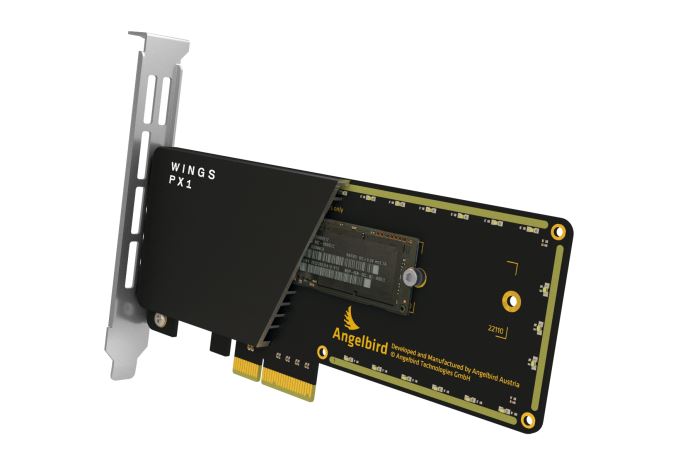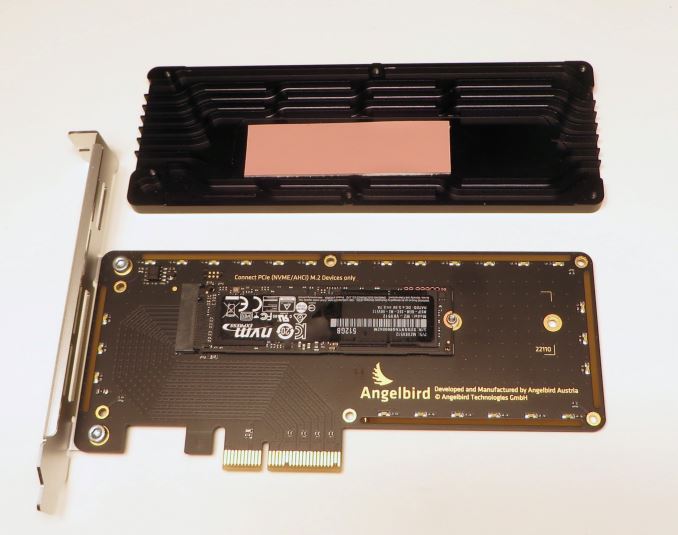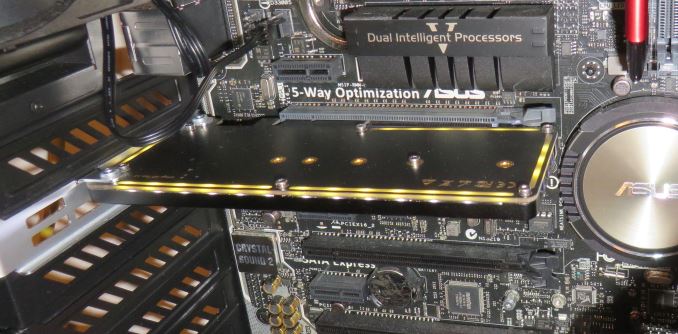The Angelbird Wings PX1 M.2 Adapter Review: Do M.2 SSDs Need Heatsinks?
by Billy Tallis on December 21, 2015 8:00 AM EST
The M.2 form factor has quickly established itself as the most popular choice for PCIe SSDs in the consumer space. The small size easily fits in to most laptop designs, and the ability to provide up to four lanes of PCI Express accommodates even the fastest SSDs. By comparison, SATA Express never caught on and never will due to its two-lane limitation. And the more recent U.2 (formerly SFF-8639) does have traction, but has seen little adoption in the client market.
Meanwhile, although M.2 has its perks it also has its disadvantages, often as a consequence of space. The limited PCB area of M.2 can constrain capacity: Samsung's single-sided 950 Pro is only available in 256GB or 512GB capacities while the 2.5" SATA 850 Pro is available in up to 2TB. And for Intel, the controller used in their SSD 750 is outright too large for M.2, as it's wider than the most common M.2 form factor (22mm by 80mm). Finally and most recently, as drive makers have done more to take advantage of the bandwidth offered by PCIe, a different sort of space limitation has come to the fore: heat.
When testing the Samsung SM951 we found that our heavier sustained I/O tests could trigger thermal throttling that would periodically restrict the drive's performance. We also had a brief opportunity to run some of our tests on the SM951 using the heatsink from Plextor's M6e Black Edition. We found that extra cooling made noticeable differences in performance on some of our synthetic benchmarks, but our more realistic AnandTech Storage Bench tests showed little or no change. But other than the quick look at the SM951, we haven't had the chance to do a thorough comparison of how cooling affects high-performance M.2 drives, until now.
Austrian SSD manufacturer Angelbird has released a new PCIe to M.2 adapter: the Wings PX1. With an aluminum heatsink and thermal pads to conduct heat away from both sides of an SSD, the PX1 aims to provide M.2 drives with the same cooling capacity that larger add-in card SSDs have. Angelbird doesn't currently sell a M.2 PCIe SSD, so the Wings PX1 is intended to complement other M.2 SSDs, especially drives like Samsung's 950 Pro. As a passive adapter, it supports PCIe drives using either the AHCI or NVMe protocols, but it does not support M.2 SATA drives due to the lack of a SATA connector to pass through a connection from elsewhere on the motherboard. The M.2 connector connector is keyed in the 'M' position, indicating support for up to four PCIe lanes, and it is also compatible with M.2 drives that use two PCIe lanes and are typically notched in the 'B' and 'M' positions.
Aesthetically, the Wings PX1 is for the most part quite plain. The exterior of the heatsink is a smooth slab of aluminum with a matte black finish adorned with the product name and Angelbird's logo. The PCB is is also a plain black, with the regulatory markings and product name printed on the back in the same gold as the electrical contacts. Tucked under the heatsink is the glaring exception to the otherwise unassuming design: 25 white LEDs line the perimeter of the card, shining through the gap between the PCB and the heatsink and glowing through translucent channels near the edge of the card where the black finish was omitted. For users who don't want the illumination, it can be disabled by removing the zero-ohm resistor in the corner of the board. This might void the warranty, but it's a pretty safe modification to do since the LEDs are running solely off the 12V supply and the drive is powered entirely from the 3.3V circuits.
To assess the effectiveness of the PX1's heatsink, I've tested the Samsung 950 Pro in the Wings PX1 with and without the heatsink and thermal pads installed, while subjected to most of our usual client SSD test suite. Our initial review of the 950 Pro turned up clear signs of at least some thermal throttling, but did not explore the full extent of the impact of temperature on performance. One confounding factor is that our testbed does not have working support for PCIe Active State Power Management (ASPM). Without it and with no added cooling, the 950 Pro's idle power consumption was enough to heat it up to the point that transistor leakage added another 5% to its power draw compared to running at room temperature.
The Wings PX1 was tested in the upper-most PCIe x16 slot in our testbed, providing it with unobstructed airflow from the intake fan of the Corsair Carbide 200R case. The fan speeds were regulated according to the motherboard's "Silent" profile and run around 900 RPM. There were no other expansion cards installed to generate heat in the vicinity of the PX1 or to affect airflow.
Meanwhile, now that we're revisiting the Samsung 950 Pro and its sensitivity to cooling, we've realized that some of the results reported in our original review reflected an inconsistent thermal environment for the drive, which we've gone ahead and corrected for with this article. In our original review, I added a fan mid-way through testing after experiencing some system instabilities in order to rule out overheating (it turned out to be power delivery). Consequently, some of the results from those runs with a fan were used in the final review and made the 256GB 950 Pro occasionally appear much faster than the 512GB model. So ahead of this review, I've gone back and corrected the scores in our SSD Bench database to consistently reflect a normal cooling environment without a heatsink or dedicated fan.
Finally, let's talk about pricing and availability. The Angelbird Wings PX1 has a MSRP of $75 USD/€66 EUR and comes with a 10 year warranty. RamCity is the initial distributor for the Wings PX1, which is currently listed on their website for AUD$100.90 and will also be sold through their Amazon storefront.
| AnandTech 2015 SSD Test System | |
| CPU | Intel Core i7-4770K running at 3.5GHz (Turbo & EIST enabled, C-states disabled) |
| Motherboard | ASUS Z97 Deluxe (BIOS 2501) |
| Chipset | Intel Z97 |
| Chipset Drivers | Intel 10.0.24+ Intel RST 13.2.4.1000 |
| Memory | Corsair Vengeance DDR3-1866 2x8GB (9-10-9-27 2T) |
| Graphics | Intel HD Graphics 4600 |
| Graphics Drivers | 15.33.8.64.3345 |
| Desktop Resolution | 1920 x 1200 |
| OS | Windows 8.1 x64 |
- Thanks to Intel for the Core i7-4770K CPU
- Thanks to ASUS for the Z97 Deluxe motherboard
- Thanks to Corsair for the Vengeance 16GB DDR3-1866 DRAM kit, RM750 power supply, Carbide 200R case, and Hydro H60 CPU cooler


















69 Comments
View All Comments
Haravikk - Monday, December 21, 2015 - link
I think I could only see this being useful if you were building a system loaded with SSDs in the PCIe slots; in a system with a GPU I'd expect the extra heat from that will easily result in worse performance than keeping the M.2 drive on the motherboard.In fact, for a single M.2 SSD system my preference is a motherboard with an M.2 slot on the back; this keeps it away from the worst heat generating components, and even though few cases provide proper airflow on the back of the motherboard, as long as your cooling is adequate it should never get too hot for the drive.
Even if you are building a system with a ton of SSDs, the main benefit is having the PCIe adapter IMO, it doesn't seem like the heatsink makes such a big difference that you're ever really going to notice it.
vFunct - Monday, December 21, 2015 - link
This is going to be mostly useful in servers, where sustained (non-burst) read/write is typical.Ethos Evoss - Saturday, December 26, 2015 - link
Now new NVMe M.2 SSDs NEED heatsink totally bcos PCIe 3.0 x4 has very very high bandwidth and generates 100 C degrees celsius !Ethos Evoss - Saturday, December 26, 2015 - link
https://www.youtube.com/watch?v=d3GlInzvHr8frowertr - Monday, December 21, 2015 - link
Really think M.2 is the future. No cables and small size sounds like a winner to me.ImSpartacus - Monday, December 21, 2015 - link
It's probably the future, but it'll take a while to get there.If you need a cheap ssd for a boring boot drive, then 2.5" is the way to go if you have anything close to resembling a budget.
frowertr - Monday, December 21, 2015 - link
Yeah I agree. But they will figure out how to get more capacity at lower costs packed onto the size factor soon enough. I just built a new Skylake build for my living room HTPC/Xbox one look a like, and I used the Samsung EVO m.2 drive. What a refreshing piece of hardware. Just clipping it onto the motherboard like RAM and not dealing with any cables whatsoever made me feel like I was living in the future. Can't believe how far HDDs have come since I started building computers in the mid-90s.Lonyo - Monday, December 21, 2015 - link
The only reason consumer SSDs are 2.5" is because that's what the space is. If you had a 1.8" drive slot, and 1.8" drives, then SSDs would be smaller. They are the size they are because 2.5" was around for mechanical drives before SSDs, so it allows drop in replacement.The problem with M2 is that you end up having a space limitation because you need to free up space on the motherboard to put the thing, which means either you skip something else, or you have a larger motherboard, and then you aren't really saving any space anyway.
DanNeely - Monday, December 21, 2015 - link
Using the 1.8" HDD form factor probably would have impacted higher end drives in prior years. It only has 60% of the areal size of a 2.5" model; and until fairly recently most high performance/capacity SSDs; used a full size 2.5" PCB. The only ones that were using cut down boards that would fit into a 1.8" housing without needing shrunk were lower end budget models. While it doesn't matter much now (Samsung's 2tb models use smaller PCBs that look like they'd almost fit in the smaller form factor unchanged); cropping off the largest size from the market a few years ago would've probably hurt adoption.MrSpadge - Monday, December 21, 2015 - link
I fail to see a good reason why SSDs have to become more expensive if you remove their case. Anything on that M.2 card is also in a 2.5" drive, yet it's no problem to fit the components onto that small PCB (as long as you're not trying to make very large drives).